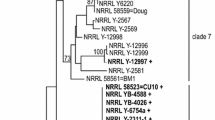Abstract
Poly(β-L-malic acid) (PMA) is a natural biopolyester that has pharmaceutical applications and other potential uses. In this study, we examined PMA production by 56 strains of the fungus Aureobasidium pullulans representing genetically diverse phylogenetic clades. Thirty-six strains were isolated from various locations in Iceland and Thailand. All strains from Iceland belonged to a newly recognized clade 13, while strains from Thailand were distributed among 8 other clades, including a novel clade 14. Thirty of these isolates, along with 26 previously described strains, were examined for PMA production in medium containing 5% glucose. Most strains produced at least 4 g PMA/L, and several strains in clades 9, 11, and 13 made 9–11 g PMA/L. Strains also produced both pullulan and heavy oil, but PMA isolated by differential precipitation in ethanol exhibited up to 72% purity with no more than 12% contamination by pullulan. The molecular weight of PMA from A. pullulans ranged from 5.1 to 7.9 kDa. Results indicate that certain genetic groups of A. pullulans are promising for the production of PMA.


Similar content being viewed by others
References
Braud C, Bunel C, Vert M (1985) Poly(β-malic acid): a new polymeric drug-carrier. Evidence for degradation in vitro. Polym Bull 13:293–299
Deshpande MS, Rale VB, Lynch JM (1992) Aureobasidium pullulans in applied microbiology: a status report. Enzyme Microbial Technol 14:514–527
Fischer H, Erdmann S, Holler E (1989) An unusual polyanion from Physarum polycephalum that inhibits homologous DNA polymerase in vitro. Biochem 28:5219–5226
Hibbett DS et al (2007) A higher-level phylogenetic classification of the fungi. Mycol Res 111:509–547
Holler E, Angerer B, Achhammer G, Miller S, Windisch C (1992) Biological and biosynthetic properties of poly-L-malate. FEMS Microbiol Rev 103:109–118
Kurosawa T, Sakai K, Nakahara T, Oshima Y, Tabuchi T (1994) Extracellular accumulation of the polyol lipids, 3, 5-dihydroxydecanoyl and 5-hydroxy-2-decenoyl esters of arabitol and mannitol, by Aureobasidium sp. Biosci Biotech Biochem 58:2057–2060
Leathers TD (1989) Purification and properties of xylanase from Aureobasidium. J Ind Microbiol 4:341–348
Leathers TD (2002) Pullulan. In: Vandamme EJ, De Baets S, Steinbuchel A (eds) Biopolymers, vol 6, polysaccharides II: polysaccharides from eukaryotes. Wiley-VCH, Weinheim, pp 1–35
Lee BS, Maurer T, Kalbitzer HR, Holler E (1999) β-Poly(L-malate) production by Physarum polycephalum: 13C Nuclear magnetic resonance studies. Appl Microbiol Biotechnol 52:415–420
Liu S, Steinbuchel A (1996) Investigation of poly(β-L-malic acid) production by strains of Aureobasidium pullulans. Appl Microbiol Biotechnol 46:273–278
Ljubimova JY, Fujita M, Khazenzon NM, Lee BS, Wachsmann-Hogiu S, Farkas DL, Black KL, Holler E (2008) Nanoconjugate based on polymalic acid for tumor targeting. Chemico-Biol Interact 171:195–203
Luengo JM, Garcia B, Sandoval A, Naharro G, Olivera ER (2003) Bioplastics from microorganisms. Curr Opin Microbiol 6:251–260
Manitchotpisit P, Leathers TD, Peterson SW, Kurtzman CP, Li X-L, Eveleigh DE, Lotrakul P, Prasongsuk S, Dunlap CA, Vermillion KE, Punnapayak H (2009) Multilocus phylogenetic analyses, pullulan production and xylanase activity of tropical isolates of Aureobasidium pullulans. Mycol Res 113:1107–1120
Manitchotpisit P, Price NPJ, Leathers TD, Punnapayak H (2011) Heavy oils produced by Aureobasidium pullulans. Biotechnol Lett 33:1151–1157
Nagata N, Nakahara T, Tahuchi T (1993) Fermentative production of poly(β-L-malic acid), a polyelectronic biopolyester by Aureobasidium sp. Biosci Biotech Biochem 57:638–642
Nakajima-Kambe T, Hirotani N, Nakahara T (1996) Poly(beta-malic acid) production by the non-growing cells of Aureobasidium sp strain A-91. J Ferm Bioeng 82:411–413
Schoch CL, Shoemaker RA, Seifert KA, Hambleton S, Spatafora JW, Crous PW (2006) A multigene phylogeny of the Dothideomycetes using four nuclear loci. Mycologia 98:1041–1052
Shimada K, Matsushi K, Fukumoto J, Yamamoto T (1969) Poly-(L)-malic acid—a new protease inhibitor from Penicillium cyclopium. Biochem Biophy Res Commun 35:619–624
Singh RS, Saini GK, Kennedy JF (2008) Pullulan: microbial sources, production and applications. Carbohydr Polym 73:515–531
Steinbuchel A, Valentin HE (1995) Diversity of bacterial polyhydroxyalkanoic acids. FEMS Microbiol Lett 128:219–228
Swofford DL (2003) PAUP*: phylogenetic analysis using parsimony, version 4.0b10. Sinauer Associates, Sunderland
Thompson JD, Higgins DG, Gibson TJ (1994) CLUSTAL W: improving the sensitivity of progressive multiple sequence alignment through sequence weighting, position-specific gap penalties and weight matrix choice. Nucleic Acids Res 22:4673–4680
Vert M (1998) Chemical routes to poly(β-malic acid) and potential applications of this water-soluble bioresorbable poly(β-hydroxy alkanoate). Polym Degrad Stab 59:169–175
Zalar P, Gostincar C, de Hoog GS, Ursic V, Sudhadham M, Gunde-Cimerman N (2008) Redefinition of Aureobasidium pullulans and its varieties. Stud Mycol 61:21–38
Acknowledgments
The authors acknowledge RSU grant number 37/52 from the Research Center of Rangsit University for partial financial support. Appreciation is expressed for the kind assistance provided by Kristina Glenzinski, Melinda Nunnally, and Trina Hartman. Poly(β-L-malic acid) from P. polycephalum (M w 30,000) was the kind gift of Dr. Eggehard Holler, Cedars-Sinai Medical Center.
Author information
Authors and Affiliations
Corresponding author
Additional information
“Mention of a trade name, proprietary product, or specific equipment does not constitute a guarantee or warranty by the United States Department of Agriculture and does not imply its approval to the exclusion of other products that may be suitable. USDA is an equal opportunity provider and employer.”
Rights and permissions
About this article
Cite this article
Manitchotpisit, P., Skory, C.D., Peterson, S.W. et al. Poly(β-L-malic acid) production by diverse phylogenetic clades of Aureobasidium pullulans . J Ind Microbiol Biotechnol 39, 125–132 (2012). https://doi.org/10.1007/s10295-011-1007-7
Received:
Accepted:
Published:
Issue Date:
DOI: https://doi.org/10.1007/s10295-011-1007-7




